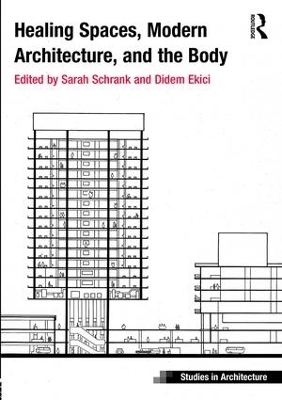
Healing Spaces, Modern Architecture, and the Body
Routledge (Verlag)
978-1-4724-7083-6 (ISBN)
Healing Spaces, Modern Architecture, and the Body brings together cutting-edge scholarship examining the myriad ways that architects, urban planners, medical practitioners, and everyday people have applied modern ideas about health and the body to the spaces in which they live, work, and heal. The book’s contributors explore North American and European understandings of the relationship between physical movement, bodily health, technological innovation, medical concepts, natural environments, and architectural settings from the nineteenth century through the heyday of modernist architectural experimentation in the 1920s and 1930s and onward into the 1970s. Not only does the book focus on how professionals have engaged with the architecture of healing and the body, it also explores how urban dwellers have strategized and modified their living environments themselves to create a kind of vernacular modernist architecture of health in their homes, gardens, and backyards. This new work builds upon a growing interdisciplinary field incorporating the urban humanities, geography, architectural history, the history of medicine, and critical visual studies that reflects our current preoccupation with the body and its corresponding therapeutic culture.
Sarah Schrank is Professor of History at California State University, Long Beach where she teaches graduate and undergraduate courses in United States women’s history, urban history, body theory, popular environmentalism, and critical visual studies. She received her PhD in United States history from the University of California, San Diego and has held research fellowships from the Haynes Foundation, The Huntington Library, the Shelby Cullom Davis Center at Princeton University, and The Wolfsonian-Florida International University. She is the author of Art and the City: Civic Imagination and Cultural Authority in Los Angeles (University of Pennsylvania Press, 2009) as well as numerous essays and articles on public art, urbanism, vernacular architecture, and American body culture. She is currently completing two new books, Naked: Natural Living and the American Cult of the Body for the University of Pennsylvania Press’s Nature and Culture series and Urban History Goes to the Movies: The City in the American Popular Imagination for Routledge. Didem Ekici is Assistant Professor in the Department of Architecture and Built Environment at the University of Nottingham. She is the author of several articles and chapters that explore the relationship between modern architecture, health, body culture, and asceticism as well as the city and memory. Her current research focuses on the transformation of architecture regarding concepts of the body in the German-speaking world of the nineteenth and early twentieth-centuries. It is supported by grants from Wellcome Trust in Medical History and Humanities and the German Academic Exchange.
Introduction by Sarah Schrank and Didem Ekici Part 1: Interior Spaces and Everyday Therapeutic Architecture 1: Naked Houses: The Architecture of Nudism and the Rethinking of the American Suburbs Sarah Schrank 2: Inputs, Outputs, Flows: The Bio-Architecture of Whole Systems Design, the Energy Pavilion, and the Integral Urban House Sabrina Gabrielle Richard 3: The Physiology of the House: Modern Architecture and the Science of Hygiene Didem Ekici 4: Material Heliotechnics: A Tale of Two Bodies John Stanislav Sadar 5:Isolation, Privacy, Control and Privilege: Psychiatric Architecture and the Single Room Leslie Topp Part 2: Healing Landscapes and the Body Out-of-Doors 6: Freeing Bodies and Prescribing Play in the Humanization of New York City: Richard Dattner’s 1960s Playgrounds Camille Shamble 7: Garden Walks: Physical Mobility and Social Identity and Dumbarton Oaks Robin Veder 8: Shaping Fascist Bodies: Children’s Summer Camps in Fascist Italy Stephanie Pilat 9: Bodies at Work and Leisure: Therapeutic Landscapes of Early Nineteenth-Century New York State Insane Asylums Jennifer L. Thomas Part 3: Public Health and Modern Medical Institutions 10: Designing the Medical Museum Annmarie Adams 11: The Decline of the Hospital as a Healing Machine David Theodore 12: Passive and Active: Public Space at the McMaster Health Sciences Center, 1972 Thomas Strickland Index
| Erscheinungsdatum | 24.05.2016 |
|---|---|
| Reihe/Serie | Ashgate Studies in Architecture |
| Zusatzinfo | 11 Line drawings, black and white; 68 Halftones, black and white |
| Verlagsort | London |
| Sprache | englisch |
| Maße | 174 x 246 mm |
| Gewicht | 610 g |
| Themenwelt | Sachbuch/Ratgeber ► Gesundheit / Leben / Psychologie |
| Studium ► Querschnittsbereiche ► Prävention / Gesundheitsförderung | |
| Naturwissenschaften ► Biologie ► Ökologie / Naturschutz | |
| Naturwissenschaften ► Geowissenschaften ► Geografie / Kartografie | |
| Sozialwissenschaften ► Soziologie | |
| Technik ► Architektur | |
| ISBN-10 | 1-4724-7083-4 / 1472470834 |
| ISBN-13 | 978-1-4724-7083-6 / 9781472470836 |
| Zustand | Neuware |
| Haben Sie eine Frage zum Produkt? |
aus dem Bereich


